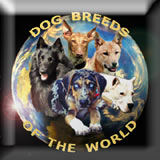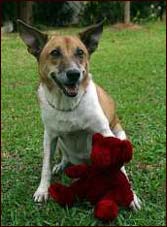Telomian
(Malaysian Telemonian)
.
.
.
.
The Canine Information Library 2003-2008 © All rights reserved. Photos © Eric Isselée (Shar pei puppy, Chinese crested); Nikita Tiunov (Basenji)
No part of bulldoginformation.com may be copied, distributed, printed or reproduced on another website without the owner's written permission.
Introduction
The only Malaysian dog breed known outside Malaysia, even if the breed remains extremely rare.
Appearance
The Telomian looks very similar to other feral and primitive dogs: a mid-sized, square built dog with erect ears and a coat that is parti-colored black-and-white, fawn-and-white or black-and-tan. The larger the color patches, the better.
Origin
The Telomian was named after the Sungai Telom valley in Pahang where this breed was first found by American scientists.
Telomians were used as vermin-controlling hunting dogs by the Orang Asli (the indigenous peoples of Peninsular Malaysia) to protect their settlements against rats and snakes.
Temperament
Their owners describe them as extremely intelligent, naturally alert and obedient. They are avid hunters and particularly enjoy searching objects, such as hidden treats (and edible garbage).
Telomians love to play and run, and are attracted to almost anything (balls, fris-bees, toads, skunks) making them excellent pets for children. They are versatile dogs, which adapt easily and readily to all kinds of situations.
A quite unique ability of these dogs is the way they use their paws to hold toys and open doors, much the same way humans do. Another striking characteristic is their climbing ability (see 'Origin'). They produce a strange howling sound, similar to that of the Basenji and New Guinea Singing Dog. Like these breeds, the females only have one period of heat a year.
Another outstanding trait is their alertness for dangerous animals (like snakes) and their awareness of dangerous natural elements, like poisonous plants, something probably passed down from their origins in Malaysia's jungle.
Early socialization is very important in this breed. A maximum amount of human handling should start at the age of four to five weeks, thus earlier than the peak socialization period of other breeds. Without this bonding, Telomions remain aloof to people and unable to adjust to new situations. If socialized, Telomians become marvelous and fascinating companions, especially with children.
Further reading:
An outstanding wholly Malaysian breed by Dr Susanna Bradi
That is because, by nightfall, the rainforest fauna, snakes, scorpions, poisonous insects, army ants, and hungry mammals, all roam the forest floor and use thermal (heat seeking) sensors and nightvision to locate and attack their preys. That is why Organ Asli aborigines never build their huts on bare ground.
As these tribes were the original inhabitants of the jungle they had developed a particular type of settlement that consisted of huts on stilts.
As their pets, Telomians thus developed a rare climbing ability, which allowed them to climb the wooden ladders used to reach their owners' huts.
The first Telomians to appear in the West were a pair obtained by the anthropologisht Orville Elliot in 1963. They were successfully bred in the United States and a Telomian Dog Club was established in 1970. Another Telomian pair was imported in 1973 and it is believed that all Telomians in the West descend from just these two domesticated pairs.
Some cynologists believe the Telomian may be the 'missing link' between the (African) Basenji and the (Australian) Dingo.
Like the Chow Chow, most Telomians have a blue-black colored tongue, probably a reminiscence of the ancient Asian breeds.
Source: The Atlas of Dog Breeds of the World by Bonnie Wilcox, TFH
The Atlas of Dog Breeds of the World
Books including a short section about the Telomian:
Dogs: The Ultimate Dictionary of Over 1,000 Dog Breeds
by Desmond Morris
More information:







